An Analysis of Market Structures and Resource Allocation in Economics
VerifiedAdded on 2020/02/24
|21
|4192
|67
Essay
AI Summary
This economics essay comprehensively analyzes four key market structures: monopoly, monopolistic competition, oligopoly, and perfect competition. It defines each structure, highlighting their characteristics, such as the number of firms, product differentiation, and barriers to entry. The essay provides real-world examples, including Nepal Oil Corporation as a monopoly and various companies in monopolistic competition and oligopoly. It delves into the concepts of profit maximization in the short and long run for each market structure, illustrating how firms achieve supernormal profits and the impact of competition. Furthermore, the essay explores resource allocation efficiency across the different market structures, emphasizing the inefficiencies associated with monopolies and monopolistic competition. The analysis covers topics like price setting, marginal cost, and the underutilization of resources, providing a thorough understanding of how these structures affect market outcomes.
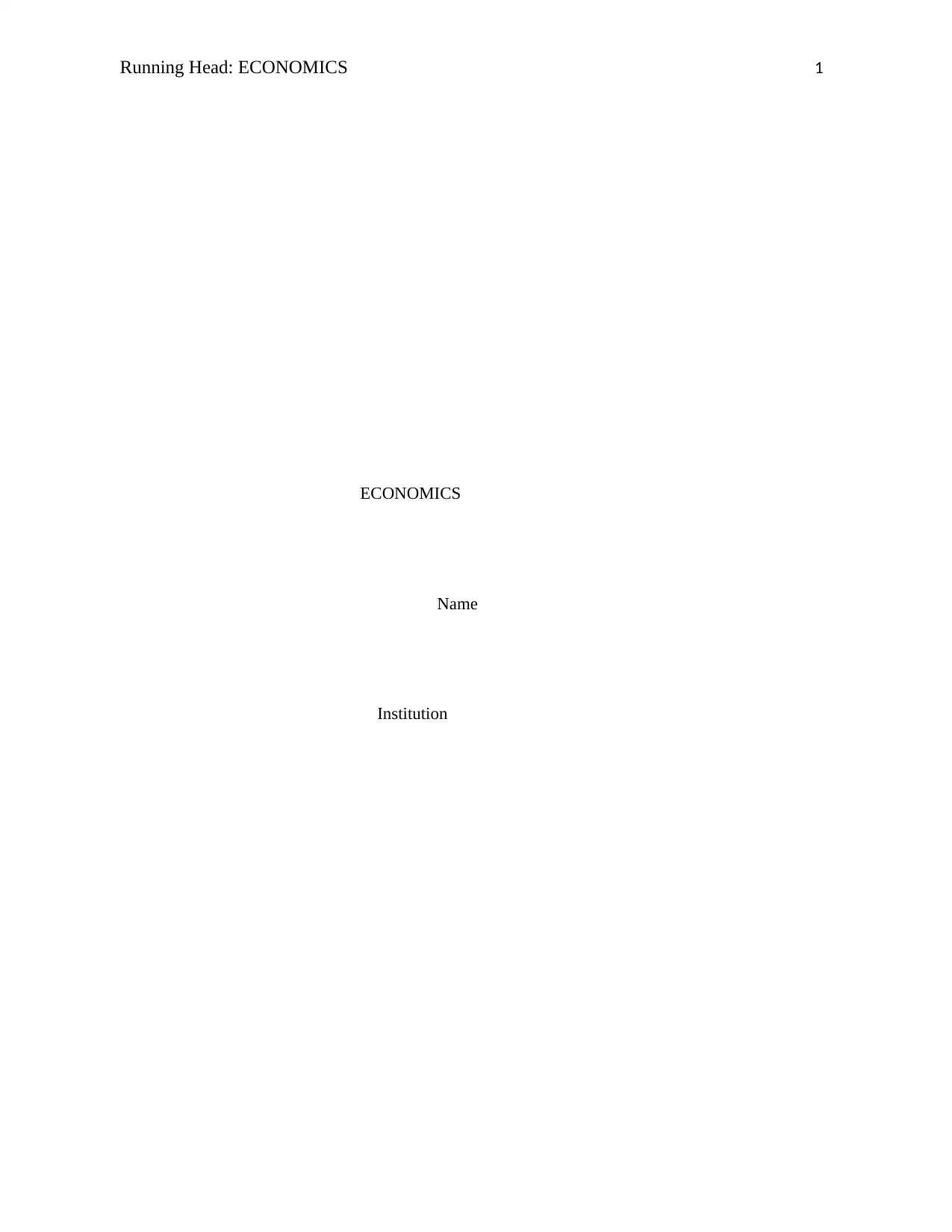
Running Head: ECONOMICS 1
ECONOMICS
Name
Institution
ECONOMICS
Name
Institution
Paraphrase This Document
Need a fresh take? Get an instant paraphrase of this document with our AI Paraphraser
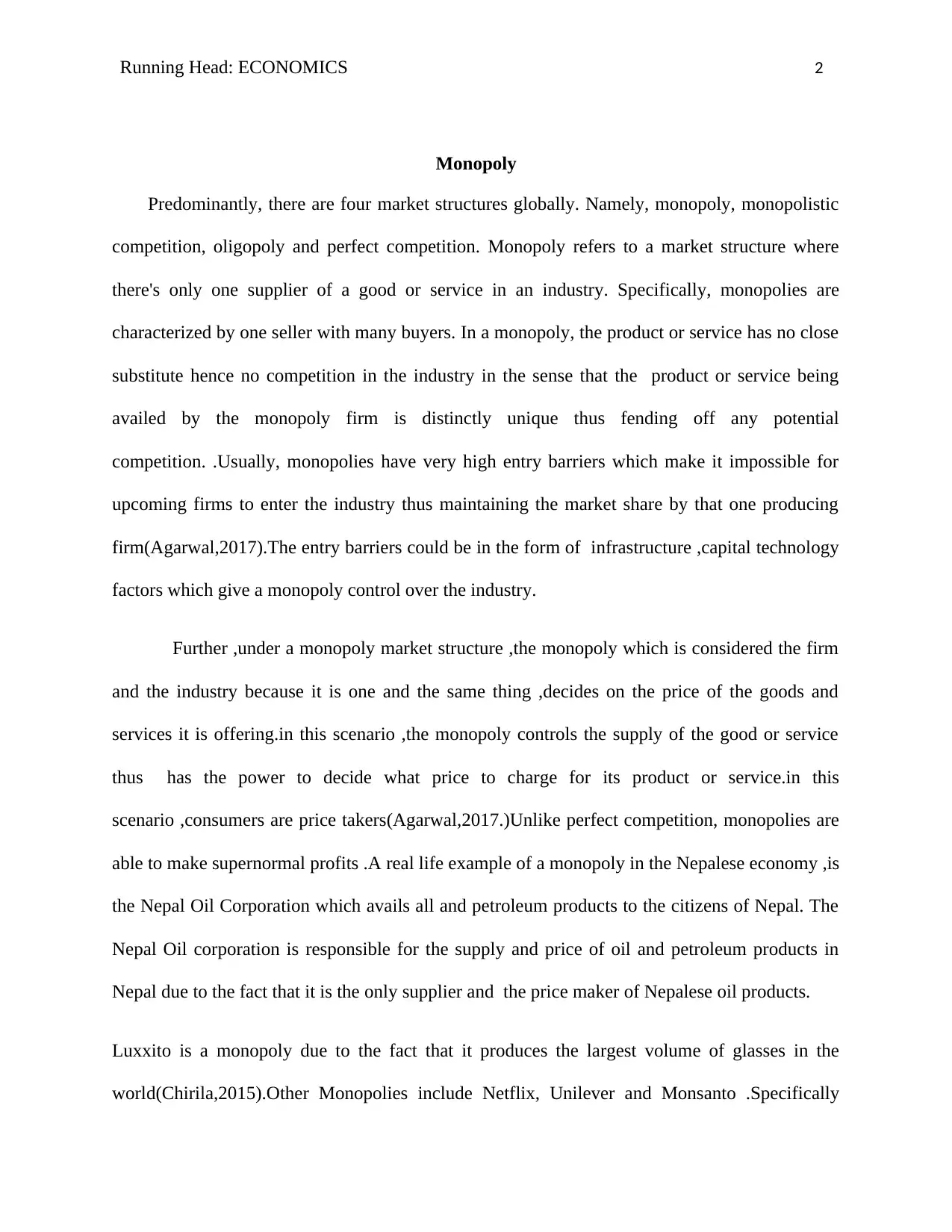
Running Head: ECONOMICS 2
Monopoly
Predominantly, there are four market structures globally. Namely, monopoly, monopolistic
competition, oligopoly and perfect competition. Monopoly refers to a market structure where
there's only one supplier of a good or service in an industry. Specifically, monopolies are
characterized by one seller with many buyers. In a monopoly, the product or service has no close
substitute hence no competition in the industry in the sense that the product or service being
availed by the monopoly firm is distinctly unique thus fending off any potential
competition. .Usually, monopolies have very high entry barriers which make it impossible for
upcoming firms to enter the industry thus maintaining the market share by that one producing
firm(Agarwal,2017).The entry barriers could be in the form of infrastructure ,capital technology
factors which give a monopoly control over the industry.
Further ,under a monopoly market structure ,the monopoly which is considered the firm
and the industry because it is one and the same thing ,decides on the price of the goods and
services it is offering.in this scenario ,the monopoly controls the supply of the good or service
thus has the power to decide what price to charge for its product or service.in this
scenario ,consumers are price takers(Agarwal,2017.)Unlike perfect competition, monopolies are
able to make supernormal profits .A real life example of a monopoly in the Nepalese economy ,is
the Nepal Oil Corporation which avails all and petroleum products to the citizens of Nepal. The
Nepal Oil corporation is responsible for the supply and price of oil and petroleum products in
Nepal due to the fact that it is the only supplier and the price maker of Nepalese oil products.
Luxxito is a monopoly due to the fact that it produces the largest volume of glasses in the
world(Chirila,2015).Other Monopolies include Netflix, Unilever and Monsanto .Specifically
Monopoly
Predominantly, there are four market structures globally. Namely, monopoly, monopolistic
competition, oligopoly and perfect competition. Monopoly refers to a market structure where
there's only one supplier of a good or service in an industry. Specifically, monopolies are
characterized by one seller with many buyers. In a monopoly, the product or service has no close
substitute hence no competition in the industry in the sense that the product or service being
availed by the monopoly firm is distinctly unique thus fending off any potential
competition. .Usually, monopolies have very high entry barriers which make it impossible for
upcoming firms to enter the industry thus maintaining the market share by that one producing
firm(Agarwal,2017).The entry barriers could be in the form of infrastructure ,capital technology
factors which give a monopoly control over the industry.
Further ,under a monopoly market structure ,the monopoly which is considered the firm
and the industry because it is one and the same thing ,decides on the price of the goods and
services it is offering.in this scenario ,the monopoly controls the supply of the good or service
thus has the power to decide what price to charge for its product or service.in this
scenario ,consumers are price takers(Agarwal,2017.)Unlike perfect competition, monopolies are
able to make supernormal profits .A real life example of a monopoly in the Nepalese economy ,is
the Nepal Oil Corporation which avails all and petroleum products to the citizens of Nepal. The
Nepal Oil corporation is responsible for the supply and price of oil and petroleum products in
Nepal due to the fact that it is the only supplier and the price maker of Nepalese oil products.
Luxxito is a monopoly due to the fact that it produces the largest volume of glasses in the
world(Chirila,2015).Other Monopolies include Netflix, Unilever and Monsanto .Specifically
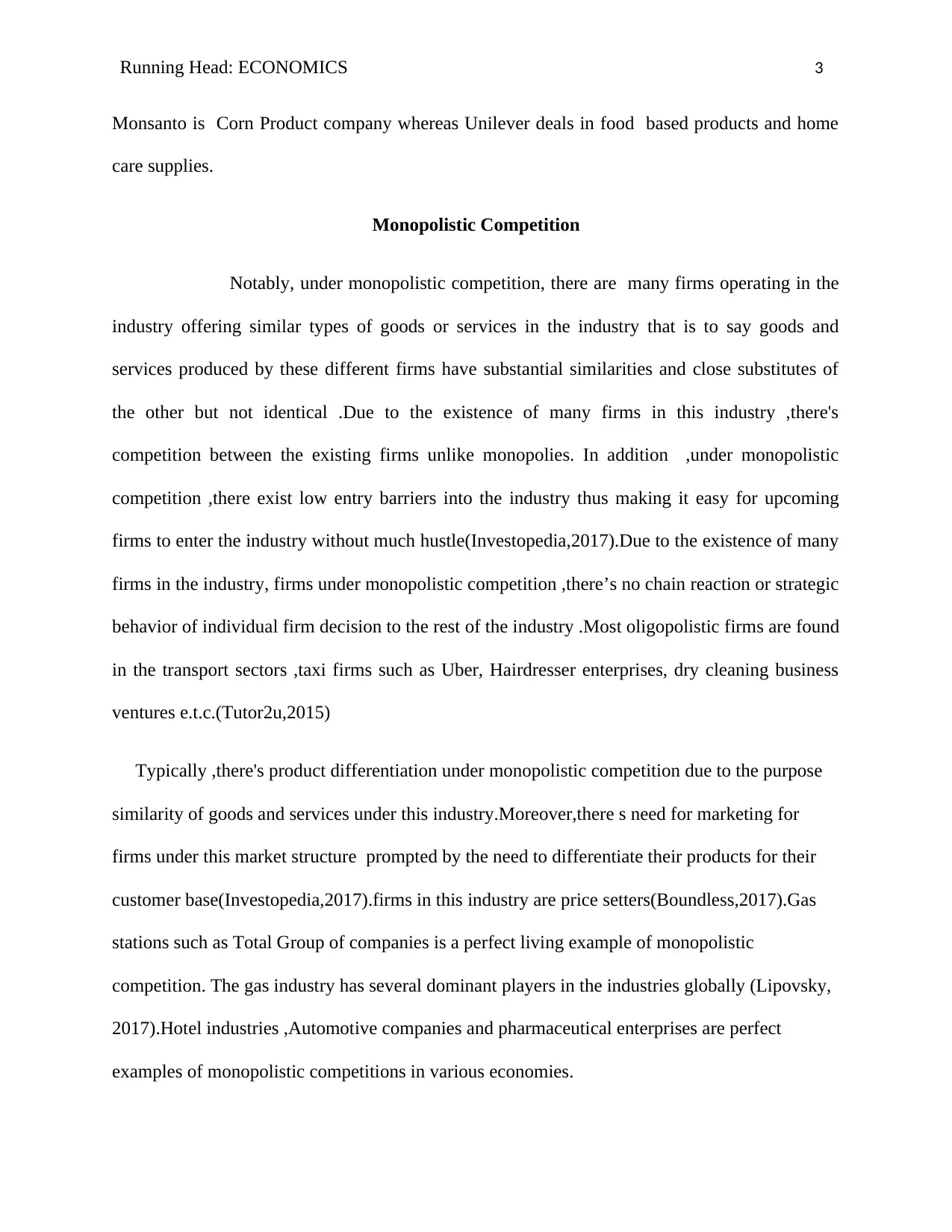
Running Head: ECONOMICS 3
Monsanto is Corn Product company whereas Unilever deals in food based products and home
care supplies.
Monopolistic Competition
Notably, under monopolistic competition, there are many firms operating in the
industry offering similar types of goods or services in the industry that is to say goods and
services produced by these different firms have substantial similarities and close substitutes of
the other but not identical .Due to the existence of many firms in this industry ,there's
competition between the existing firms unlike monopolies. In addition ,under monopolistic
competition ,there exist low entry barriers into the industry thus making it easy for upcoming
firms to enter the industry without much hustle(Investopedia,2017).Due to the existence of many
firms in the industry, firms under monopolistic competition ,there’s no chain reaction or strategic
behavior of individual firm decision to the rest of the industry .Most oligopolistic firms are found
in the transport sectors ,taxi firms such as Uber, Hairdresser enterprises, dry cleaning business
ventures e.t.c.(Tutor2u,2015)
Typically ,there's product differentiation under monopolistic competition due to the purpose
similarity of goods and services under this industry.Moreover,there s need for marketing for
firms under this market structure prompted by the need to differentiate their products for their
customer base(Investopedia,2017).firms in this industry are price setters(Boundless,2017).Gas
stations such as Total Group of companies is a perfect living example of monopolistic
competition. The gas industry has several dominant players in the industries globally (Lipovsky,
2017).Hotel industries ,Automotive companies and pharmaceutical enterprises are perfect
examples of monopolistic competitions in various economies.
Monsanto is Corn Product company whereas Unilever deals in food based products and home
care supplies.
Monopolistic Competition
Notably, under monopolistic competition, there are many firms operating in the
industry offering similar types of goods or services in the industry that is to say goods and
services produced by these different firms have substantial similarities and close substitutes of
the other but not identical .Due to the existence of many firms in this industry ,there's
competition between the existing firms unlike monopolies. In addition ,under monopolistic
competition ,there exist low entry barriers into the industry thus making it easy for upcoming
firms to enter the industry without much hustle(Investopedia,2017).Due to the existence of many
firms in the industry, firms under monopolistic competition ,there’s no chain reaction or strategic
behavior of individual firm decision to the rest of the industry .Most oligopolistic firms are found
in the transport sectors ,taxi firms such as Uber, Hairdresser enterprises, dry cleaning business
ventures e.t.c.(Tutor2u,2015)
Typically ,there's product differentiation under monopolistic competition due to the purpose
similarity of goods and services under this industry.Moreover,there s need for marketing for
firms under this market structure prompted by the need to differentiate their products for their
customer base(Investopedia,2017).firms in this industry are price setters(Boundless,2017).Gas
stations such as Total Group of companies is a perfect living example of monopolistic
competition. The gas industry has several dominant players in the industries globally (Lipovsky,
2017).Hotel industries ,Automotive companies and pharmaceutical enterprises are perfect
examples of monopolistic competitions in various economies.
⊘ This is a preview!⊘
Do you want full access?
Subscribe today to unlock all pages.

Trusted by 1+ million students worldwide
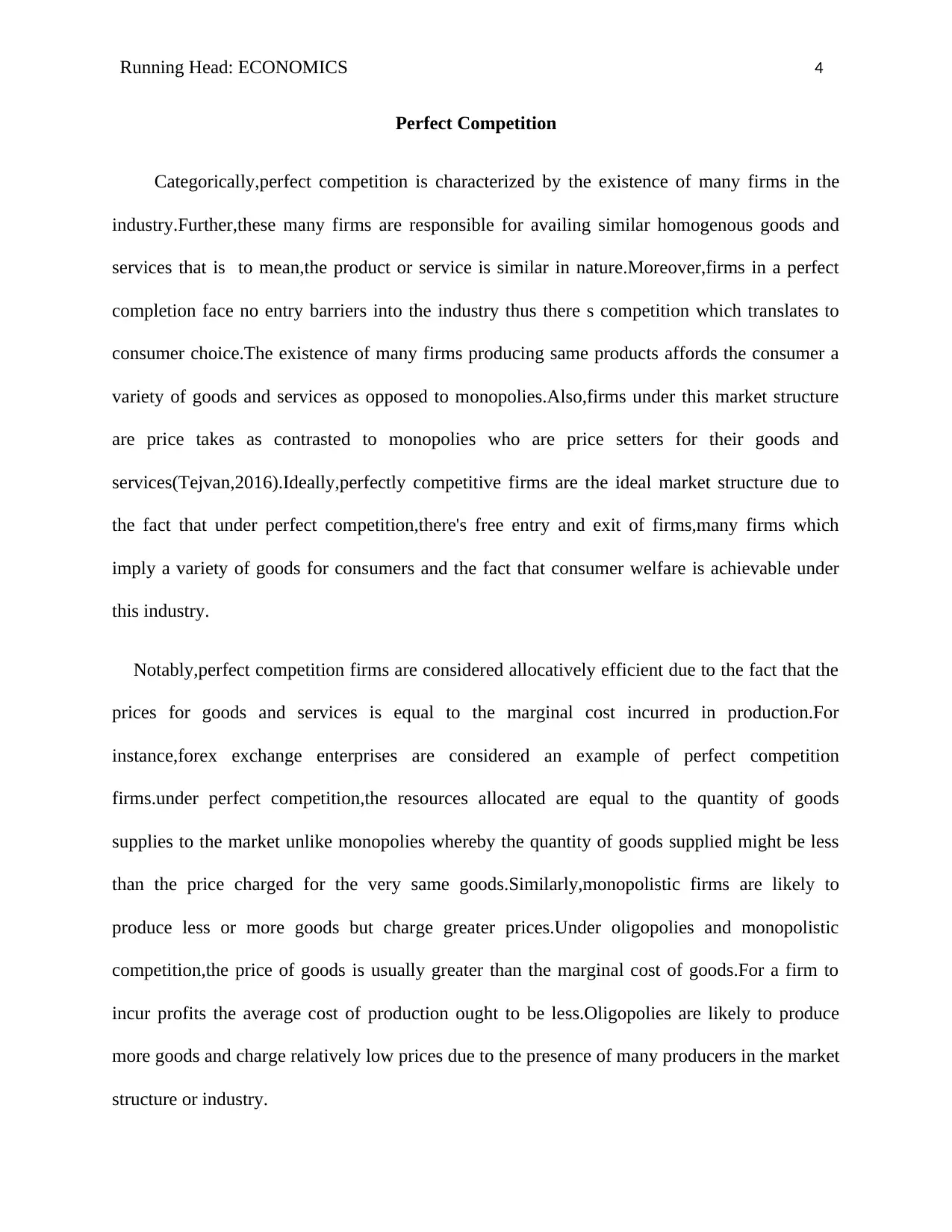
Running Head: ECONOMICS 4
Perfect Competition
Categorically,perfect competition is characterized by the existence of many firms in the
industry.Further,these many firms are responsible for availing similar homogenous goods and
services that is to mean,the product or service is similar in nature.Moreover,firms in a perfect
completion face no entry barriers into the industry thus there s competition which translates to
consumer choice.The existence of many firms producing same products affords the consumer a
variety of goods and services as opposed to monopolies.Also,firms under this market structure
are price takes as contrasted to monopolies who are price setters for their goods and
services(Tejvan,2016).Ideally,perfectly competitive firms are the ideal market structure due to
the fact that under perfect competition,there's free entry and exit of firms,many firms which
imply a variety of goods for consumers and the fact that consumer welfare is achievable under
this industry.
Notably,perfect competition firms are considered allocatively efficient due to the fact that the
prices for goods and services is equal to the marginal cost incurred in production.For
instance,forex exchange enterprises are considered an example of perfect competition
firms.under perfect competition,the resources allocated are equal to the quantity of goods
supplies to the market unlike monopolies whereby the quantity of goods supplied might be less
than the price charged for the very same goods.Similarly,monopolistic firms are likely to
produce less or more goods but charge greater prices.Under oligopolies and monopolistic
competition,the price of goods is usually greater than the marginal cost of goods.For a firm to
incur profits the average cost of production ought to be less.Oligopolies are likely to produce
more goods and charge relatively low prices due to the presence of many producers in the market
structure or industry.
Perfect Competition
Categorically,perfect competition is characterized by the existence of many firms in the
industry.Further,these many firms are responsible for availing similar homogenous goods and
services that is to mean,the product or service is similar in nature.Moreover,firms in a perfect
completion face no entry barriers into the industry thus there s competition which translates to
consumer choice.The existence of many firms producing same products affords the consumer a
variety of goods and services as opposed to monopolies.Also,firms under this market structure
are price takes as contrasted to monopolies who are price setters for their goods and
services(Tejvan,2016).Ideally,perfectly competitive firms are the ideal market structure due to
the fact that under perfect competition,there's free entry and exit of firms,many firms which
imply a variety of goods for consumers and the fact that consumer welfare is achievable under
this industry.
Notably,perfect competition firms are considered allocatively efficient due to the fact that the
prices for goods and services is equal to the marginal cost incurred in production.For
instance,forex exchange enterprises are considered an example of perfect competition
firms.under perfect competition,the resources allocated are equal to the quantity of goods
supplies to the market unlike monopolies whereby the quantity of goods supplied might be less
than the price charged for the very same goods.Similarly,monopolistic firms are likely to
produce less or more goods but charge greater prices.Under oligopolies and monopolistic
competition,the price of goods is usually greater than the marginal cost of goods.For a firm to
incur profits the average cost of production ought to be less.Oligopolies are likely to produce
more goods and charge relatively low prices due to the presence of many producers in the market
structure or industry.
Paraphrase This Document
Need a fresh take? Get an instant paraphrase of this document with our AI Paraphraser
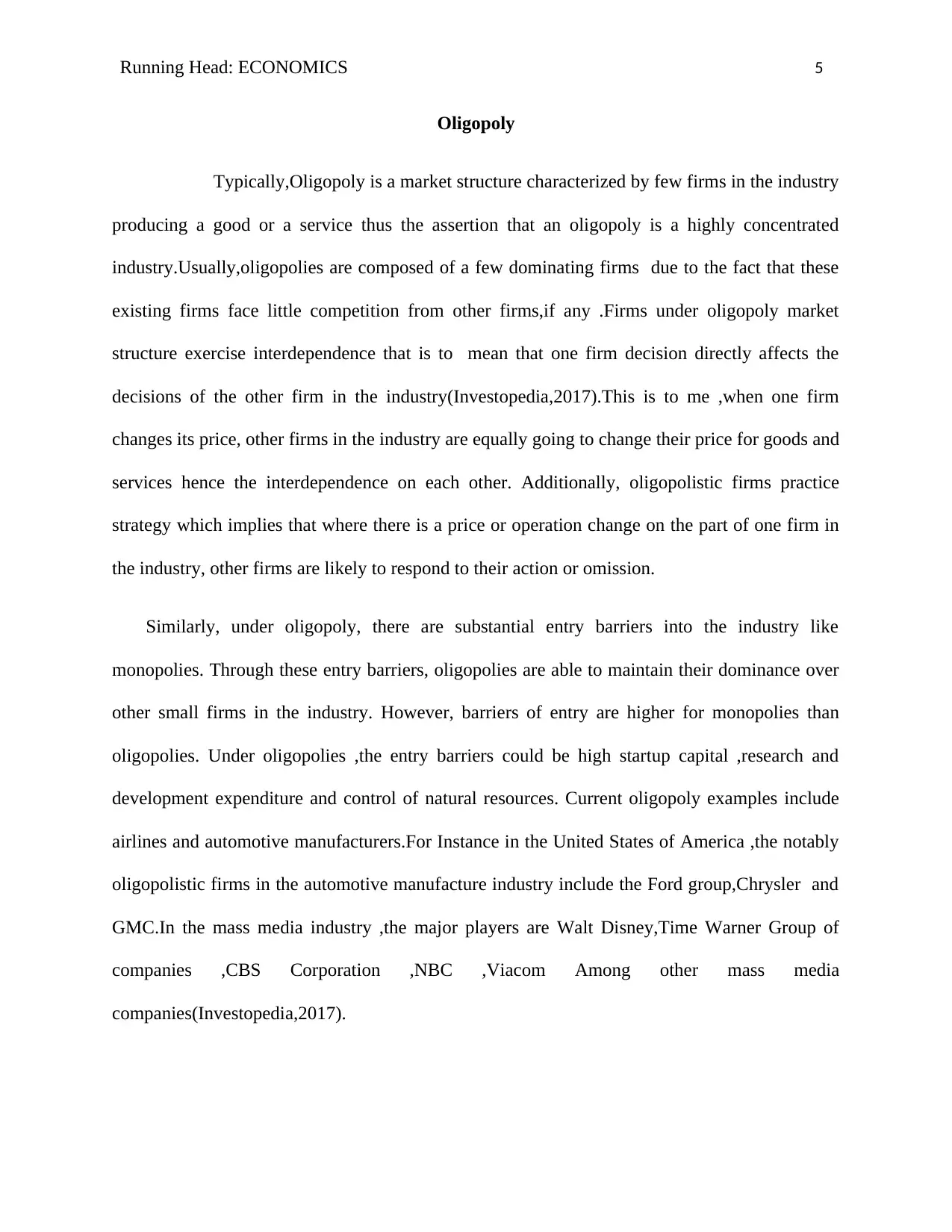
Running Head: ECONOMICS 5
Oligopoly
Typically,Oligopoly is a market structure characterized by few firms in the industry
producing a good or a service thus the assertion that an oligopoly is a highly concentrated
industry.Usually,oligopolies are composed of a few dominating firms due to the fact that these
existing firms face little competition from other firms,if any .Firms under oligopoly market
structure exercise interdependence that is to mean that one firm decision directly affects the
decisions of the other firm in the industry(Investopedia,2017).This is to me ,when one firm
changes its price, other firms in the industry are equally going to change their price for goods and
services hence the interdependence on each other. Additionally, oligopolistic firms practice
strategy which implies that where there is a price or operation change on the part of one firm in
the industry, other firms are likely to respond to their action or omission.
Similarly, under oligopoly, there are substantial entry barriers into the industry like
monopolies. Through these entry barriers, oligopolies are able to maintain their dominance over
other small firms in the industry. However, barriers of entry are higher for monopolies than
oligopolies. Under oligopolies ,the entry barriers could be high startup capital ,research and
development expenditure and control of natural resources. Current oligopoly examples include
airlines and automotive manufacturers.For Instance in the United States of America ,the notably
oligopolistic firms in the automotive manufacture industry include the Ford group,Chrysler and
GMC.In the mass media industry ,the major players are Walt Disney,Time Warner Group of
companies ,CBS Corporation ,NBC ,Viacom Among other mass media
companies(Investopedia,2017).
Oligopoly
Typically,Oligopoly is a market structure characterized by few firms in the industry
producing a good or a service thus the assertion that an oligopoly is a highly concentrated
industry.Usually,oligopolies are composed of a few dominating firms due to the fact that these
existing firms face little competition from other firms,if any .Firms under oligopoly market
structure exercise interdependence that is to mean that one firm decision directly affects the
decisions of the other firm in the industry(Investopedia,2017).This is to me ,when one firm
changes its price, other firms in the industry are equally going to change their price for goods and
services hence the interdependence on each other. Additionally, oligopolistic firms practice
strategy which implies that where there is a price or operation change on the part of one firm in
the industry, other firms are likely to respond to their action or omission.
Similarly, under oligopoly, there are substantial entry barriers into the industry like
monopolies. Through these entry barriers, oligopolies are able to maintain their dominance over
other small firms in the industry. However, barriers of entry are higher for monopolies than
oligopolies. Under oligopolies ,the entry barriers could be high startup capital ,research and
development expenditure and control of natural resources. Current oligopoly examples include
airlines and automotive manufacturers.For Instance in the United States of America ,the notably
oligopolistic firms in the automotive manufacture industry include the Ford group,Chrysler and
GMC.In the mass media industry ,the major players are Walt Disney,Time Warner Group of
companies ,CBS Corporation ,NBC ,Viacom Among other mass media
companies(Investopedia,2017).
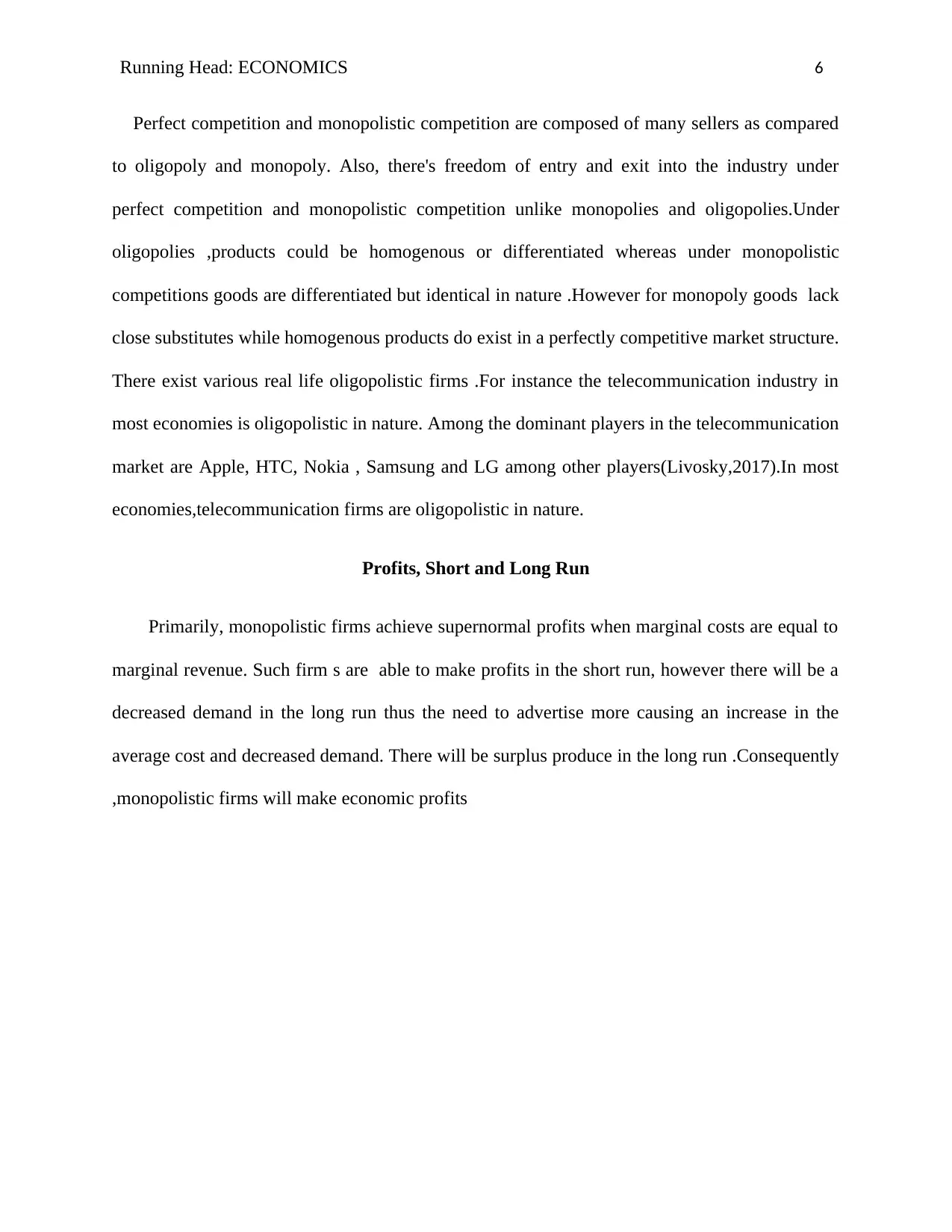
Running Head: ECONOMICS 6
Perfect competition and monopolistic competition are composed of many sellers as compared
to oligopoly and monopoly. Also, there's freedom of entry and exit into the industry under
perfect competition and monopolistic competition unlike monopolies and oligopolies.Under
oligopolies ,products could be homogenous or differentiated whereas under monopolistic
competitions goods are differentiated but identical in nature .However for monopoly goods lack
close substitutes while homogenous products do exist in a perfectly competitive market structure.
There exist various real life oligopolistic firms .For instance the telecommunication industry in
most economies is oligopolistic in nature. Among the dominant players in the telecommunication
market are Apple, HTC, Nokia , Samsung and LG among other players(Livosky,2017).In most
economies,telecommunication firms are oligopolistic in nature.
Profits, Short and Long Run
Primarily, monopolistic firms achieve supernormal profits when marginal costs are equal to
marginal revenue. Such firm s are able to make profits in the short run, however there will be a
decreased demand in the long run thus the need to advertise more causing an increase in the
average cost and decreased demand. There will be surplus produce in the long run .Consequently
,monopolistic firms will make economic profits
Perfect competition and monopolistic competition are composed of many sellers as compared
to oligopoly and monopoly. Also, there's freedom of entry and exit into the industry under
perfect competition and monopolistic competition unlike monopolies and oligopolies.Under
oligopolies ,products could be homogenous or differentiated whereas under monopolistic
competitions goods are differentiated but identical in nature .However for monopoly goods lack
close substitutes while homogenous products do exist in a perfectly competitive market structure.
There exist various real life oligopolistic firms .For instance the telecommunication industry in
most economies is oligopolistic in nature. Among the dominant players in the telecommunication
market are Apple, HTC, Nokia , Samsung and LG among other players(Livosky,2017).In most
economies,telecommunication firms are oligopolistic in nature.
Profits, Short and Long Run
Primarily, monopolistic firms achieve supernormal profits when marginal costs are equal to
marginal revenue. Such firm s are able to make profits in the short run, however there will be a
decreased demand in the long run thus the need to advertise more causing an increase in the
average cost and decreased demand. There will be surplus produce in the long run .Consequently
,monopolistic firms will make economic profits
⊘ This is a preview!⊘
Do you want full access?
Subscribe today to unlock all pages.

Trusted by 1+ million students worldwide
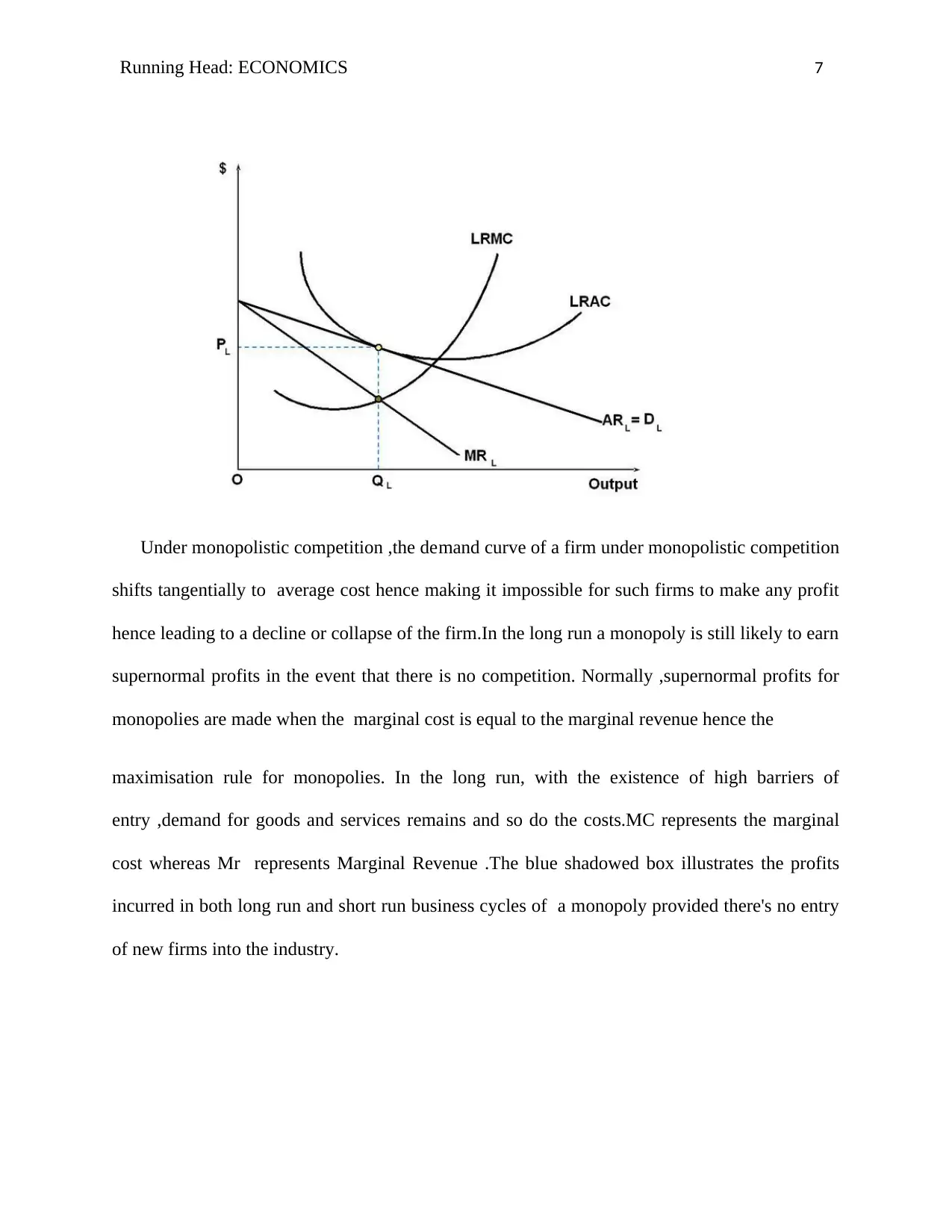
Running Head: ECONOMICS 7
Under monopolistic competition ,the demand curve of a firm under monopolistic competition
shifts tangentially to average cost hence making it impossible for such firms to make any profit
hence leading to a decline or collapse of the firm.In the long run a monopoly is still likely to earn
supernormal profits in the event that there is no competition. Normally ,supernormal profits for
monopolies are made when the marginal cost is equal to the marginal revenue hence the
maximisation rule for monopolies. In the long run, with the existence of high barriers of
entry ,demand for goods and services remains and so do the costs.MC represents the marginal
cost whereas Mr represents Marginal Revenue .The blue shadowed box illustrates the profits
incurred in both long run and short run business cycles of a monopoly provided there's no entry
of new firms into the industry.
Under monopolistic competition ,the demand curve of a firm under monopolistic competition
shifts tangentially to average cost hence making it impossible for such firms to make any profit
hence leading to a decline or collapse of the firm.In the long run a monopoly is still likely to earn
supernormal profits in the event that there is no competition. Normally ,supernormal profits for
monopolies are made when the marginal cost is equal to the marginal revenue hence the
maximisation rule for monopolies. In the long run, with the existence of high barriers of
entry ,demand for goods and services remains and so do the costs.MC represents the marginal
cost whereas Mr represents Marginal Revenue .The blue shadowed box illustrates the profits
incurred in both long run and short run business cycles of a monopoly provided there's no entry
of new firms into the industry.
Paraphrase This Document
Need a fresh take? Get an instant paraphrase of this document with our AI Paraphraser
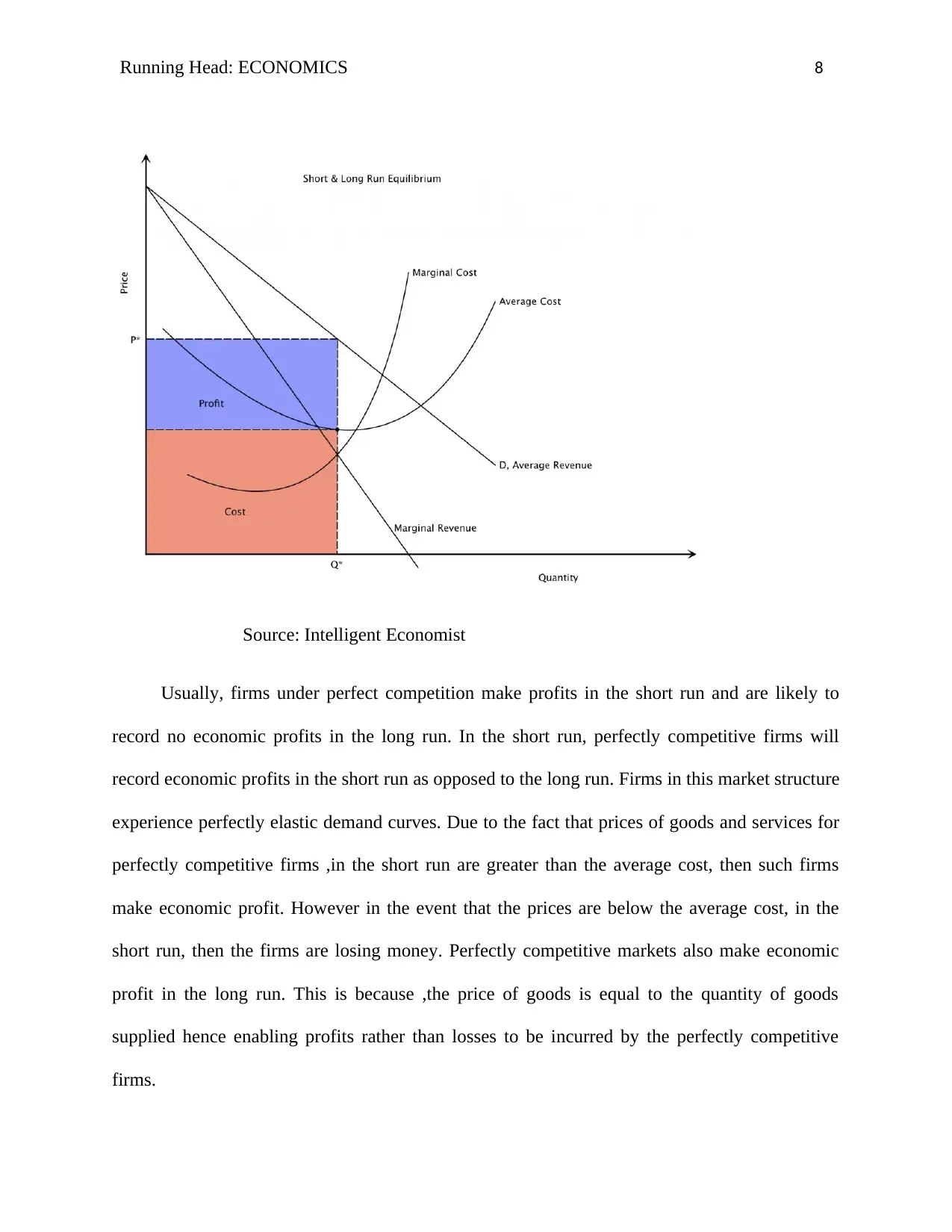
Running Head: ECONOMICS 8
Source: Intelligent Economist
Usually, firms under perfect competition make profits in the short run and are likely to
record no economic profits in the long run. In the short run, perfectly competitive firms will
record economic profits in the short run as opposed to the long run. Firms in this market structure
experience perfectly elastic demand curves. Due to the fact that prices of goods and services for
perfectly competitive firms ,in the short run are greater than the average cost, then such firms
make economic profit. However in the event that the prices are below the average cost, in the
short run, then the firms are losing money. Perfectly competitive markets also make economic
profit in the long run. This is because ,the price of goods is equal to the quantity of goods
supplied hence enabling profits rather than losses to be incurred by the perfectly competitive
firms.
Source: Intelligent Economist
Usually, firms under perfect competition make profits in the short run and are likely to
record no economic profits in the long run. In the short run, perfectly competitive firms will
record economic profits in the short run as opposed to the long run. Firms in this market structure
experience perfectly elastic demand curves. Due to the fact that prices of goods and services for
perfectly competitive firms ,in the short run are greater than the average cost, then such firms
make economic profit. However in the event that the prices are below the average cost, in the
short run, then the firms are losing money. Perfectly competitive markets also make economic
profit in the long run. This is because ,the price of goods is equal to the quantity of goods
supplied hence enabling profits rather than losses to be incurred by the perfectly competitive
firms.
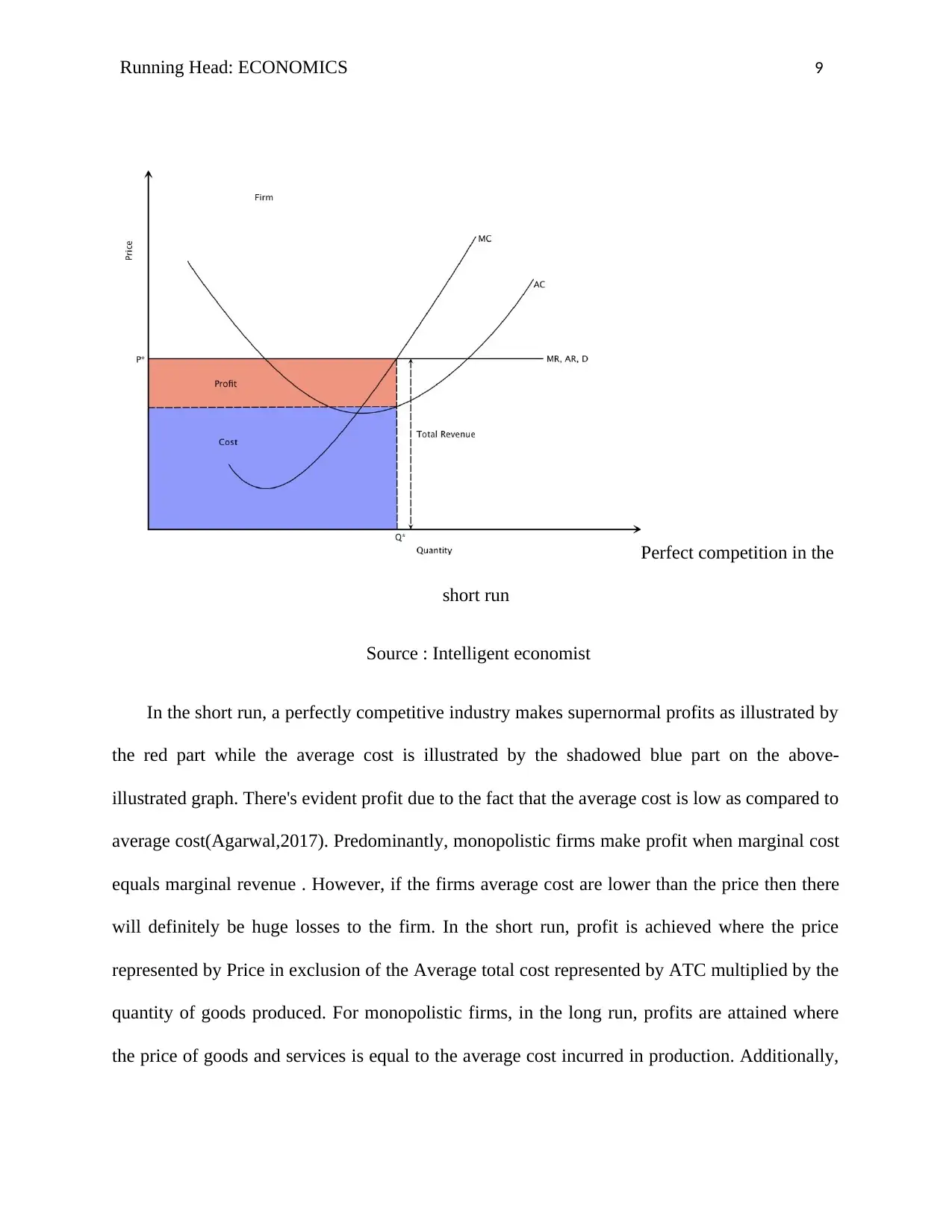
Running Head: ECONOMICS 9
Perfect competition in the
short run
Source : Intelligent economist
In the short run, a perfectly competitive industry makes supernormal profits as illustrated by
the red part while the average cost is illustrated by the shadowed blue part on the above-
illustrated graph. There's evident profit due to the fact that the average cost is low as compared to
average cost(Agarwal,2017). Predominantly, monopolistic firms make profit when marginal cost
equals marginal revenue . However, if the firms average cost are lower than the price then there
will definitely be huge losses to the firm. In the short run, profit is achieved where the price
represented by Price in exclusion of the Average total cost represented by ATC multiplied by the
quantity of goods produced. For monopolistic firms, in the long run, profits are attained where
the price of goods and services is equal to the average cost incurred in production. Additionally,
Perfect competition in the
short run
Source : Intelligent economist
In the short run, a perfectly competitive industry makes supernormal profits as illustrated by
the red part while the average cost is illustrated by the shadowed blue part on the above-
illustrated graph. There's evident profit due to the fact that the average cost is low as compared to
average cost(Agarwal,2017). Predominantly, monopolistic firms make profit when marginal cost
equals marginal revenue . However, if the firms average cost are lower than the price then there
will definitely be huge losses to the firm. In the short run, profit is achieved where the price
represented by Price in exclusion of the Average total cost represented by ATC multiplied by the
quantity of goods produced. For monopolistic firms, in the long run, profits are attained where
the price of goods and services is equal to the average cost incurred in production. Additionally,
⊘ This is a preview!⊘
Do you want full access?
Subscribe today to unlock all pages.

Trusted by 1+ million students worldwide
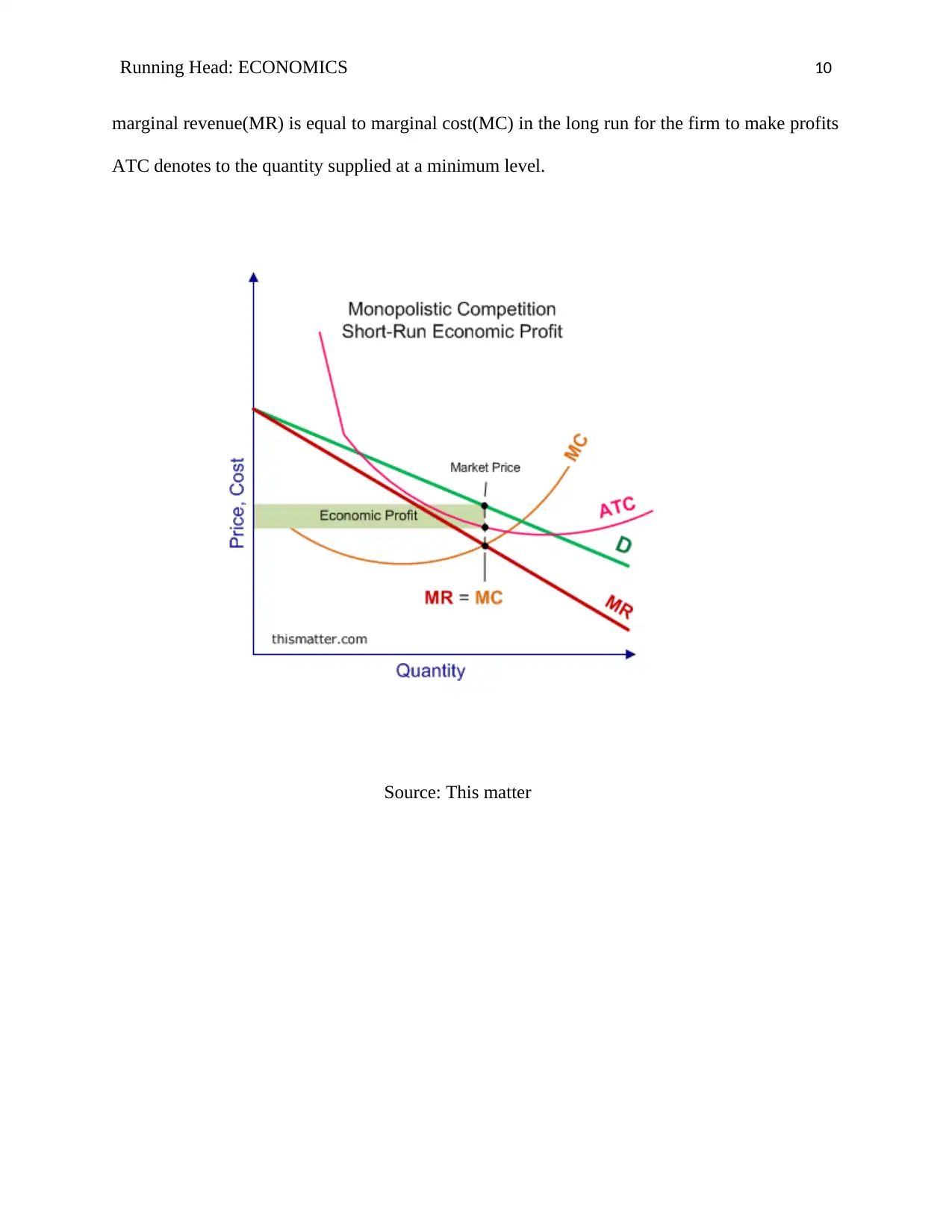
Running Head: ECONOMICS 10
marginal revenue(MR) is equal to marginal cost(MC) in the long run for the firm to make profits
ATC denotes to the quantity supplied at a minimum level.
Source: This matter
marginal revenue(MR) is equal to marginal cost(MC) in the long run for the firm to make profits
ATC denotes to the quantity supplied at a minimum level.
Source: This matter
Paraphrase This Document
Need a fresh take? Get an instant paraphrase of this document with our AI Paraphraser
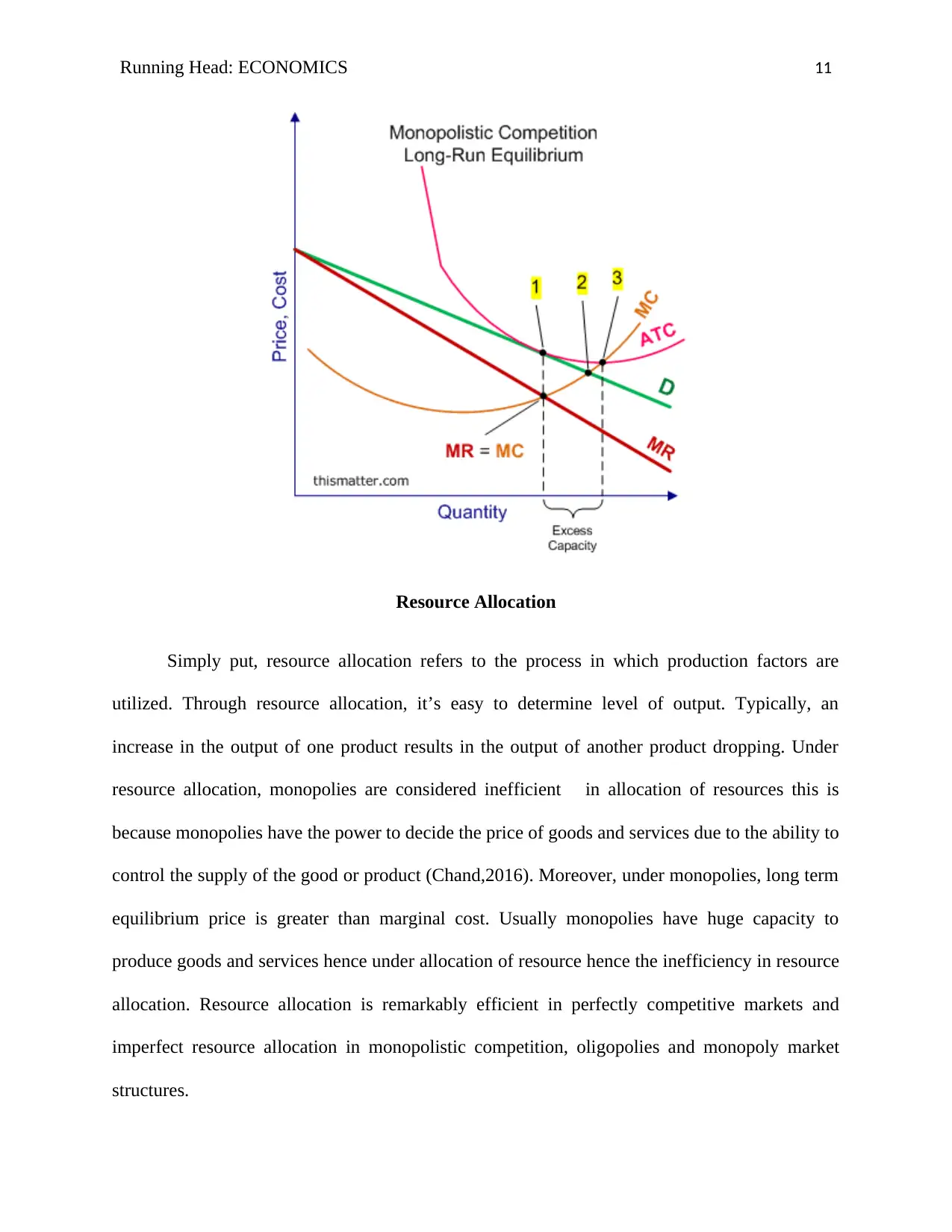
Running Head: ECONOMICS 11
Resource Allocation
Simply put, resource allocation refers to the process in which production factors are
utilized. Through resource allocation, it’s easy to determine level of output. Typically, an
increase in the output of one product results in the output of another product dropping. Under
resource allocation, monopolies are considered inefficient in allocation of resources this is
because monopolies have the power to decide the price of goods and services due to the ability to
control the supply of the good or product (Chand,2016). Moreover, under monopolies, long term
equilibrium price is greater than marginal cost. Usually monopolies have huge capacity to
produce goods and services hence under allocation of resource hence the inefficiency in resource
allocation. Resource allocation is remarkably efficient in perfectly competitive markets and
imperfect resource allocation in monopolistic competition, oligopolies and monopoly market
structures.
Resource Allocation
Simply put, resource allocation refers to the process in which production factors are
utilized. Through resource allocation, it’s easy to determine level of output. Typically, an
increase in the output of one product results in the output of another product dropping. Under
resource allocation, monopolies are considered inefficient in allocation of resources this is
because monopolies have the power to decide the price of goods and services due to the ability to
control the supply of the good or product (Chand,2016). Moreover, under monopolies, long term
equilibrium price is greater than marginal cost. Usually monopolies have huge capacity to
produce goods and services hence under allocation of resource hence the inefficiency in resource
allocation. Resource allocation is remarkably efficient in perfectly competitive markets and
imperfect resource allocation in monopolistic competition, oligopolies and monopoly market
structures.
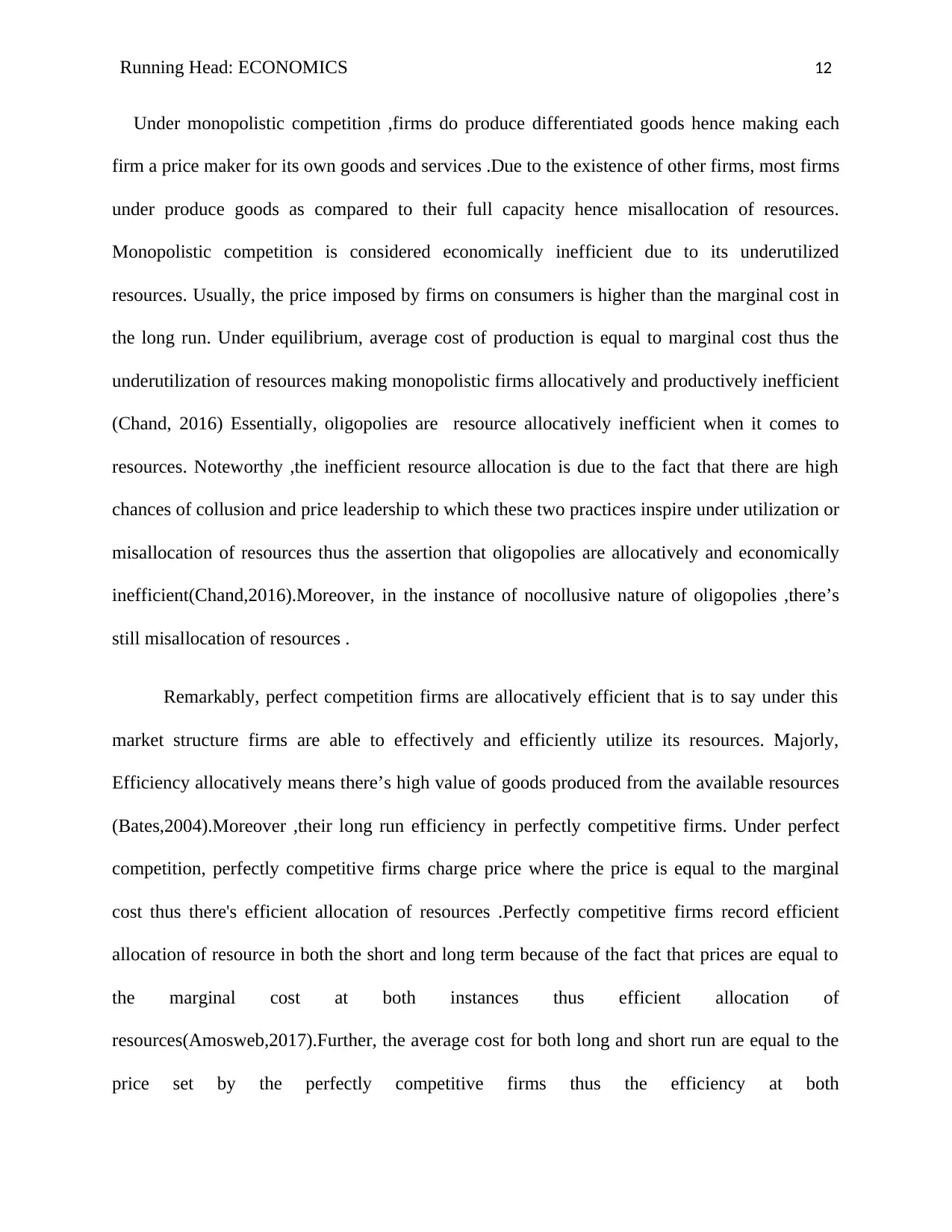
Running Head: ECONOMICS 12
Under monopolistic competition ,firms do produce differentiated goods hence making each
firm a price maker for its own goods and services .Due to the existence of other firms, most firms
under produce goods as compared to their full capacity hence misallocation of resources.
Monopolistic competition is considered economically inefficient due to its underutilized
resources. Usually, the price imposed by firms on consumers is higher than the marginal cost in
the long run. Under equilibrium, average cost of production is equal to marginal cost thus the
underutilization of resources making monopolistic firms allocatively and productively inefficient
(Chand, 2016) Essentially, oligopolies are resource allocatively inefficient when it comes to
resources. Noteworthy ,the inefficient resource allocation is due to the fact that there are high
chances of collusion and price leadership to which these two practices inspire under utilization or
misallocation of resources thus the assertion that oligopolies are allocatively and economically
inefficient(Chand,2016).Moreover, in the instance of nocollusive nature of oligopolies ,there’s
still misallocation of resources .
Remarkably, perfect competition firms are allocatively efficient that is to say under this
market structure firms are able to effectively and efficiently utilize its resources. Majorly,
Efficiency allocatively means there’s high value of goods produced from the available resources
(Bates,2004).Moreover ,their long run efficiency in perfectly competitive firms. Under perfect
competition, perfectly competitive firms charge price where the price is equal to the marginal
cost thus there's efficient allocation of resources .Perfectly competitive firms record efficient
allocation of resource in both the short and long term because of the fact that prices are equal to
the marginal cost at both instances thus efficient allocation of
resources(Amosweb,2017).Further, the average cost for both long and short run are equal to the
price set by the perfectly competitive firms thus the efficiency at both
Under monopolistic competition ,firms do produce differentiated goods hence making each
firm a price maker for its own goods and services .Due to the existence of other firms, most firms
under produce goods as compared to their full capacity hence misallocation of resources.
Monopolistic competition is considered economically inefficient due to its underutilized
resources. Usually, the price imposed by firms on consumers is higher than the marginal cost in
the long run. Under equilibrium, average cost of production is equal to marginal cost thus the
underutilization of resources making monopolistic firms allocatively and productively inefficient
(Chand, 2016) Essentially, oligopolies are resource allocatively inefficient when it comes to
resources. Noteworthy ,the inefficient resource allocation is due to the fact that there are high
chances of collusion and price leadership to which these two practices inspire under utilization or
misallocation of resources thus the assertion that oligopolies are allocatively and economically
inefficient(Chand,2016).Moreover, in the instance of nocollusive nature of oligopolies ,there’s
still misallocation of resources .
Remarkably, perfect competition firms are allocatively efficient that is to say under this
market structure firms are able to effectively and efficiently utilize its resources. Majorly,
Efficiency allocatively means there’s high value of goods produced from the available resources
(Bates,2004).Moreover ,their long run efficiency in perfectly competitive firms. Under perfect
competition, perfectly competitive firms charge price where the price is equal to the marginal
cost thus there's efficient allocation of resources .Perfectly competitive firms record efficient
allocation of resource in both the short and long term because of the fact that prices are equal to
the marginal cost at both instances thus efficient allocation of
resources(Amosweb,2017).Further, the average cost for both long and short run are equal to the
price set by the perfectly competitive firms thus the efficiency at both
⊘ This is a preview!⊘
Do you want full access?
Subscribe today to unlock all pages.

Trusted by 1+ million students worldwide
1 out of 21
Related Documents
Your All-in-One AI-Powered Toolkit for Academic Success.
+13062052269
info@desklib.com
Available 24*7 on WhatsApp / Email
![[object Object]](/_next/static/media/star-bottom.7253800d.svg)
Unlock your academic potential
Copyright © 2020–2025 A2Z Services. All Rights Reserved. Developed and managed by ZUCOL.





